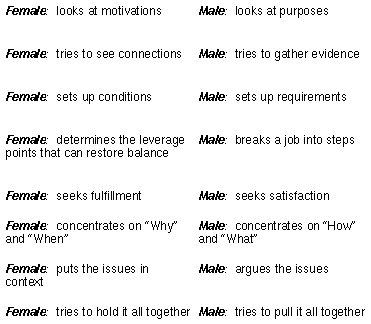Much of what we do as individuals is learned behavior. Yet, the basic operating system of the mind is cast biologically before birth as being more sensitive to space or time. We all have a sense of how things are arranged (space) and how things are going (time), but which one filters our thinking determines our Mental Sex as being Male or Female, respectively.
Male Mental Sex describes spatial thinkers who tend to use linear Problem solving as their method of choice. They set a specific Goal, determine the steps necessary to achieve that Goal, then embark on the effort to accomplish those steps.
Female Mental Sex describes temporal thinkers who tend to use holistic Problem solving as their method of choice. They get a sense of the way they want things to be, determine how things need to be balanced to bring about those changes, then make adjustments to create that balance.
While life experience, conditioning, and personal choice can go a long way toward counter-balancing those sensitivities, underneath all our experience and training the tendency to see things primarily in terms of space or time still remains. In dealing with the psychology of Main Characters, it is essential to understand the foundation upon which their experience rests.
How can we illustrate the Mental Sex of our Main Character? The following point by point comparison provides some clues:

In stories, more often than not, physical gender matches Mental Sex. From time to time, however, gender and Mental Sex are cross-matched to create unusual and interesting characters. For example, Ripley in Alien and Clarice Starling in The Silence of the Lambs are Male Mental Sex characters. Tom Wingo in The Prince of Tides and Jack Ryan in The Hunt for Red October are Female Mental Sex. In most episodes of The X Files, Scully (the female F.B.I. agent) is Male Mental Sex and Mulder (the male F.B.I. agent) is Female Mental Sex, which is part of the series’ unusual feel. Note that Mental Sex has nothing to do with a character’s sexual preferences or tendency toward being masculine or feminine in mannerism–it simply deals with the character’s problem-solving techniques.
Sometimes stereotypes are propagated by what an audience expects to see, which filters the message and dilutes the truth. By placing a female psyche in a physically male character or a male psyche in a physically female character, preconceptions no longer prevent the message from being heard. On the downside, some audience members may have trouble relating to a Main Character whose problem-solving techniques do not match the physical expectations.

